Study of the Possibility of Recycling of Technogenic Hafnium during Electron Beam Refining
Abstract
:1. Introduction
2. Materials and Methods
3. Results and Discussion
3.1. Thermodynamic Analysis of Refining Processes during EBM
3.2. Refining Efficiency during EBMR of Technogenic Hafnium
4. Conclusions
- In the temperature range of 2500–3100 K in vacuum conditions, the evaporation of the impurities Zn, Fe, and Cr, whose vapor pressure is significantly greater than that of hafnium, is most likely. The Zr vapor pressure is slightly higher, but close in value to that of Hf and its evaporation is thermodynamically probable, but it will be accompanied by losses of the base metal.
- The non-metallic impurities, oxygen and carbon, present in technogenic hafnium will most likely be removed in the form of CO(g) and CO2(g), which are products from the chemical reaction between HfC and ZrC and ZnO, FeO and Cr2O3 oxides.
- It has been found that with single refining, the maximum degree of removal of Zr (45.6%) and the best purification of hafnium technogenic material (98.982%) is achieved at a temperature of 2700 K and a refining time of 8 min. With the increase in the temperature to 2900 K, the degree of removal of Zr decreases to 41.4%, which is due to both the very small difference in the vapor pressure between Zr and Hf as well as being due to the possible chemical reactions in the Hf-Zr-O-C system, which result in liquid zirconium.
- The results from the double refining of hafnium indicate that the degree of removal of zirconium slightly increases even with prolonged refining. The lowest content of zirconium in the tested material and hafnium with the highest purity of 99.004% is achieved at T = 2700 K for 20 min and the effectiveness of refining of technogenic hafnium is 53%.
- The lowest value of hafnium micro-hardness is obtained at the highest degree of zirconium removal.
Author Contributions
Funding
Institutional Review Board Statement
Informed Consent Statement
Acknowledgments
Conflicts of Interest
References
- Zirconium and Hafnium—Comparison—Properties. Available online: https://material-properties.org/zirconium-and-hafnium-comparison-properties/ (accessed on 20 October 2022).
- Clark, R.J.H.; Bradley, D.C.; Thornton, P. The Chemistry of Titanium, Zirconium and Hafnium, 1st ed.; e-Book Texts in Inorganic Chemistry; Pergamon Press: Oxford, UK, 1973. [Google Scholar]
- Beeston, J.M. Postirradiation examination and performance of hafnium as a control rod material. Trans. Am. Nucl. Soc. 1981, 39, 399. [Google Scholar]
- Shikov, A.K.; Bocharov, O.V.; Arzhakova, V.M.; Bezumov, V.N.; Perlovich, Y.A.; Isaenkova, M.G. Use of hafnium in control elements of nuclear reactors and power units. Met. Sci. Heat Treat. 2003, 45, 300–303. [Google Scholar] [CrossRef]
- Kotsar, M.L.; Lavrikov, S.A.; Nikonov, V.I.; Aleksandrov, A.V.; Akhtonov, S.G. High-purity titanium, zirconium, and hafnium in nuclear power. At Energy 2011, 111, 92–98. [Google Scholar] [CrossRef]
- Xu, L.; Xiao, Y.; van Sandwijk, A.; Xu, Q.; Yang, Y. Production of nuclear grade zirconium: A review. J. Nucl. Mater. 2015, 466, 21–28. [Google Scholar] [CrossRef]
- Vugov, P.N.; Kojevnikov, O.E.; Rubicheva, T.U. Obtaining high-purity hafnium samples by zone melting method. Issue At. Sci. Technol. 2009, 6, 19–24. (In Russian) [Google Scholar]
- Hafnium. Available online: https://www.crmalliance.eu/hafnium (accessed on 20 October 2022).
- Vutova, K.; Vassileva, V.; Koleva, E.; Georgieva, E.; Mladenov, G.; Mollov, D.; Kardjiev, M. Investigation of electron beam melting and refining of titanium and tantalum scrap. J. Mater. Process. Technol. 2010, 210, 1089–1094. [Google Scholar] [CrossRef]
- Vutova, K.; Vassileva, V.; Koleva, E.; Munirathnam, N.; Amalnerkar, D.P.; Tanaka, T. Investigation of Tantalum Recycling by Electron Beam Melting. Metals 2016, 6, 287. [Google Scholar] [CrossRef] [Green Version]
- Vutova, K.; Stefanova, V.; Vassileva, V.; Atanasova-Vladimirova, S. Recycling of Technogenic CoCrMo Alloy by Electron Beam Melting. Materials 2022, 15, 4168. [Google Scholar] [CrossRef] [PubMed]
- Ma, Y.; Liu, Y.; Liu, W.; Long, L. Preparation procedure of high purity tungsten via electron beam side surface melting. Mater. Sci. Technol. 2014, 22, 30–35. [Google Scholar]
- You, Q.; Yuan, H.; Zhao, L.; Li, J.; You, X.; Shi, S.; Tan, Y.; Ding, X. Removal inclusions from nickel-based superalloy by induced directional solidification during electron beam smelting. Vacuum 2018, 156, 39–47. [Google Scholar] [CrossRef]
- Yu, J.; Yin, Z.; Huang, Z.; Zhao, S.; Huang, H.; Yu, K.; Zhou, R.; Xiao, H. Effect of Aging Treatment on Microstructural Evolution and Mechanical Properties of the Electron Beam Cold Hearth Melting Ti-6Al-4V Alloy. Materials 2022, 15, 7122. [Google Scholar] [CrossRef] [PubMed]
- Mladenov, G.; Koleva, E.; Vutova, K.; Vassileva, V. Practical Aspects and Application of Electron Beam Irradiation; Memtanu, M., Brasoveanu, M., Eds.; Transworld Research Network: Trivandrum, India, 2011; Chapter 3; pp. 43–93. [Google Scholar]
- HSC Chemistry ver.7.1, Outotec, Research Center Pori, Finland. 2013. Available online: http://www.hsc.chemistry.net/ (accessed on 10 October 2022).
- Kalugin, A. Electron Beam Melting of Metals; Metallurgy Publishing House: Moscow, Russia, 1980. (In Russian) [Google Scholar]
- Perevislov, S.N.; Vysotin, A.B.; Shcherbakova, O.Y. Studying the properties of carbides in the system ZrC-HfC, TaC-ZrC, TaC-HfC. IOP Conf. Ser. Mater. Sci. Eng. 2020, 848, 1–5. [Google Scholar] [CrossRef]
- Bobrov, U.P.; Virich, V.D.; Dimitrenko, A.E.; Koblik, D.V.; Kovtun, G.P.; Manjos, V.V.; Pilipenko, N.N.; Tancura, I.G.; Shterban, A.P. Refining of Ruthenium by electron beam melting. Quest. At. Sci. Technol. Vac. Pure Mater. Supercond. 2011, 6, 11–17. (In Russian) [Google Scholar]
- Kubaschewski, O.; Alcock, C.B. Metallurgical Thermochemistry, 5th ed.; Pergamon Press Ltd.: Oxford, UK, 1979. [Google Scholar]
- Ushakov, S.V.; Navrotsky, A.; Hong, Q.J.; van de Walle, A. Carbides and Nitrides of Zirconium and Hafnium. Materials 2019, 12, 2728. [Google Scholar] [CrossRef] [PubMed]
- Réjasse, F.; Rapaud, O.; Trolliard, G.; Masson, O.; Maître, A. Experimental investigation and thermodynamic evaluation of the C–Hf–O ternary system. J. Am. Ceram. Soc. 2017, 100, 3757–3770. [Google Scholar] [CrossRef]
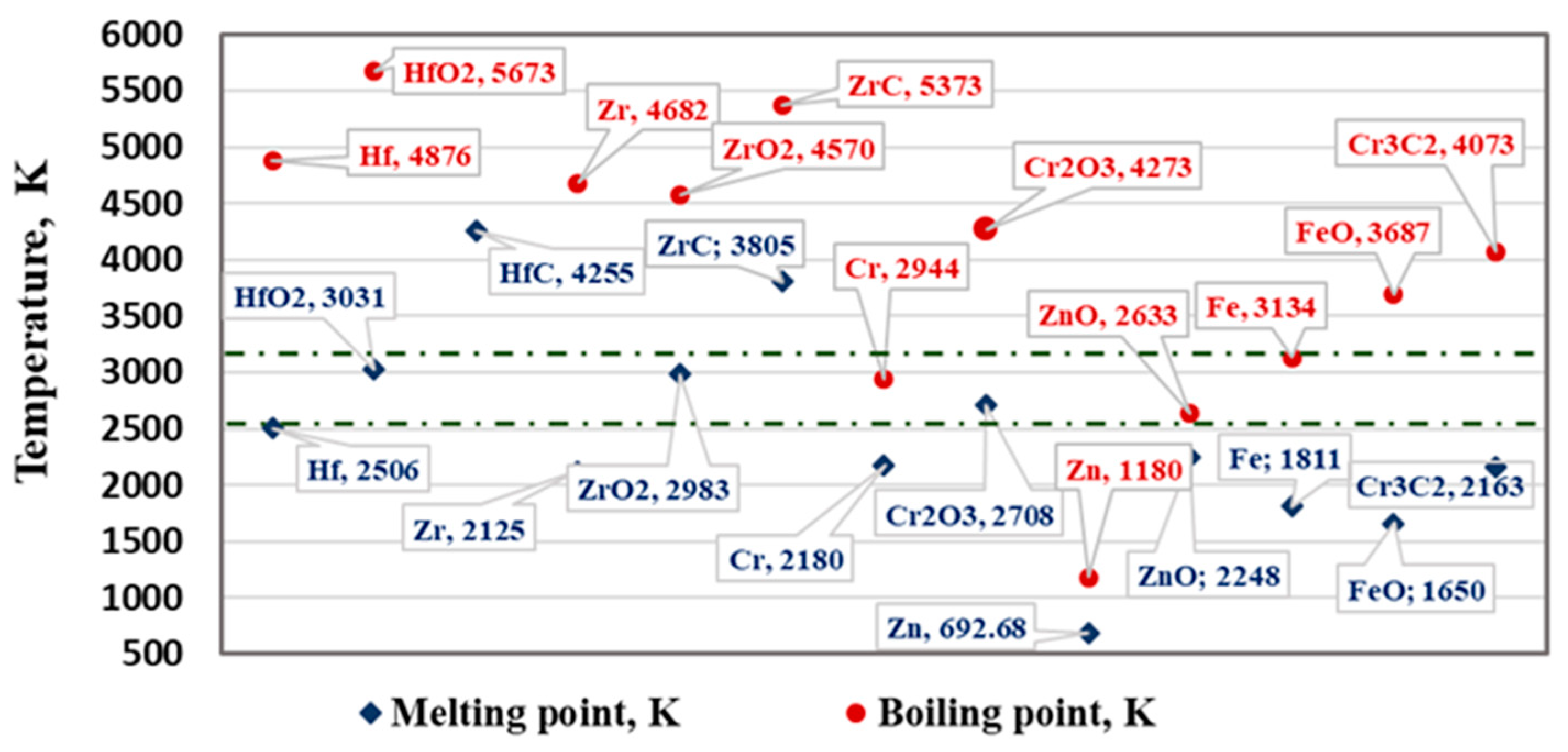
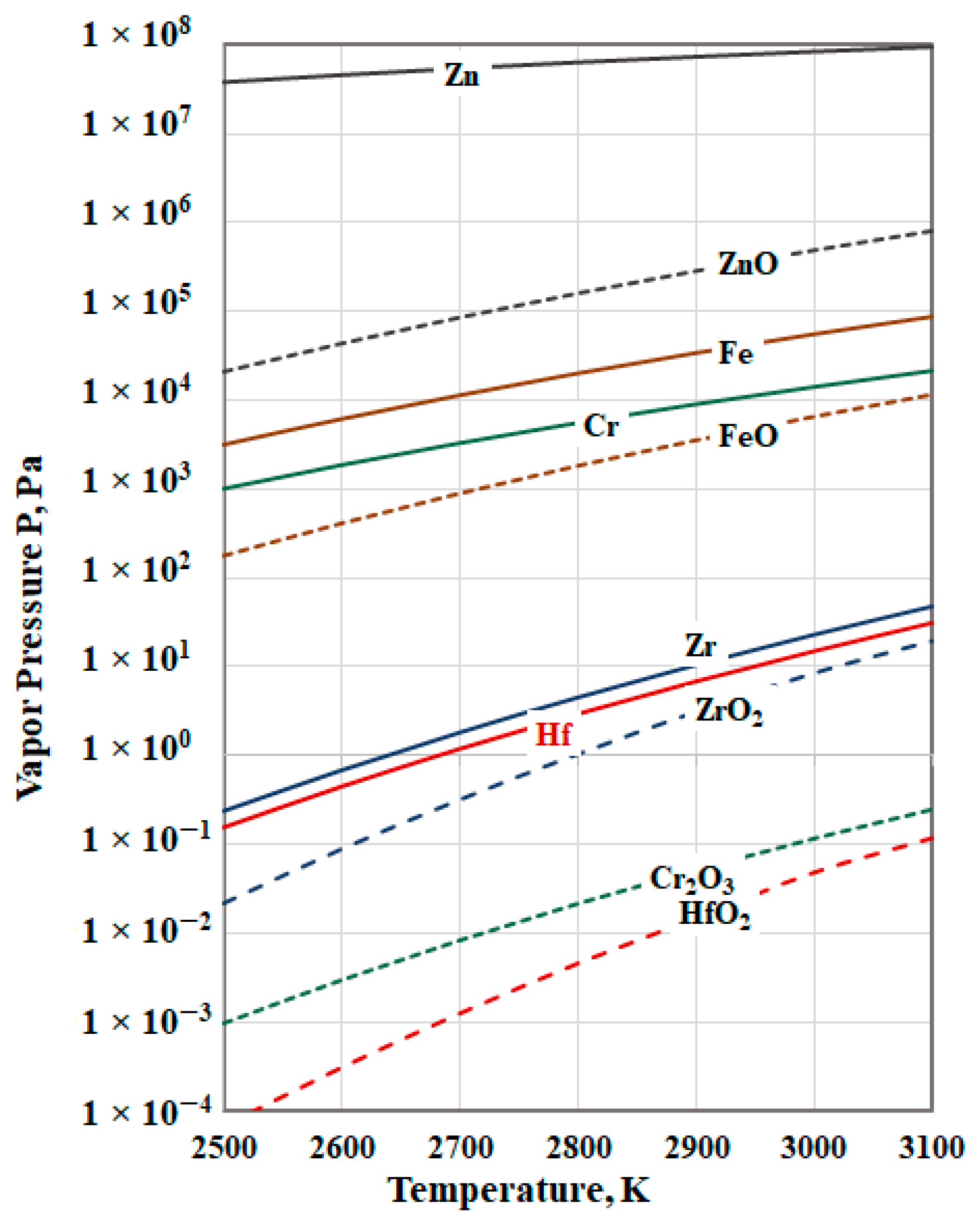
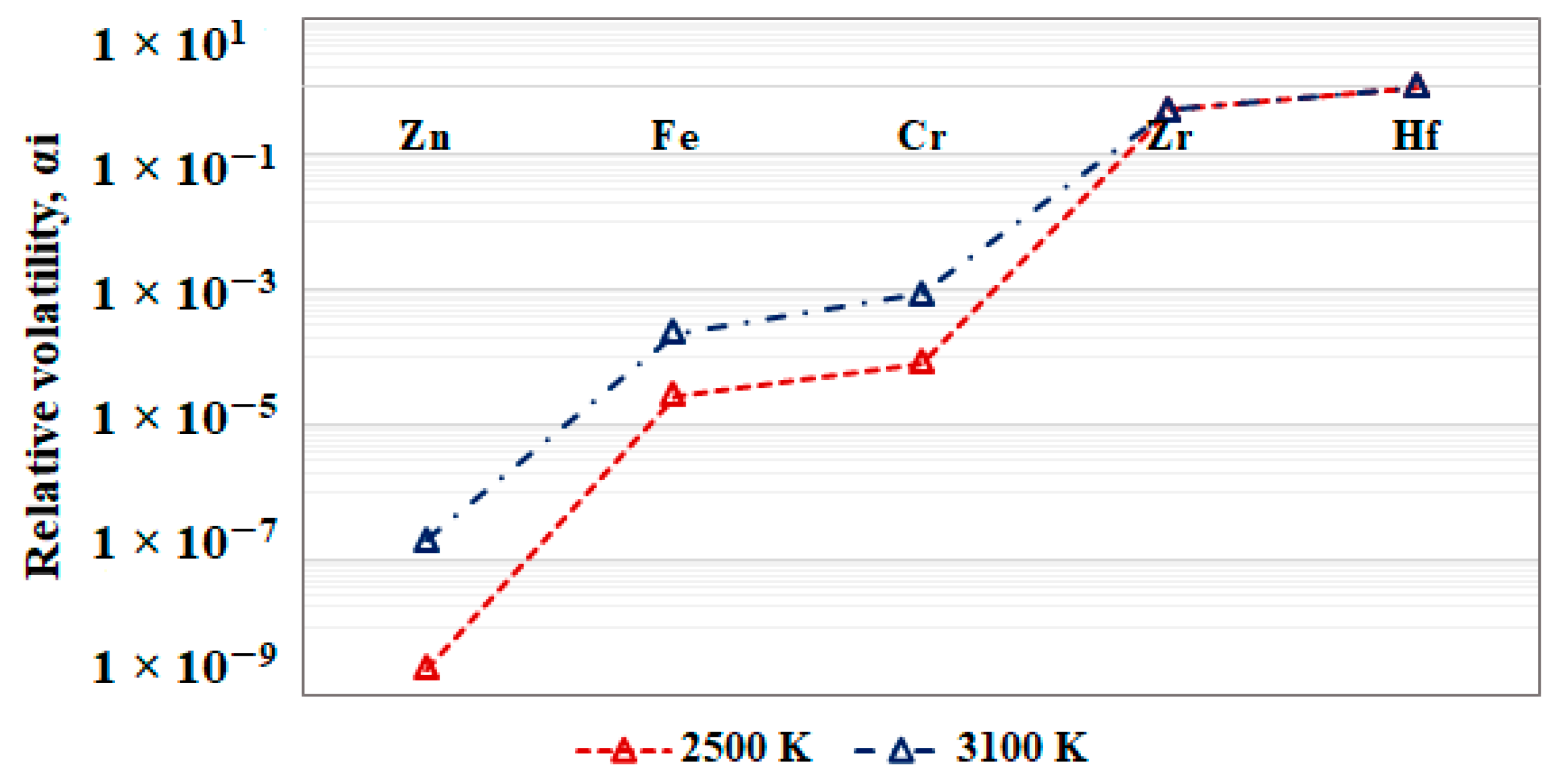
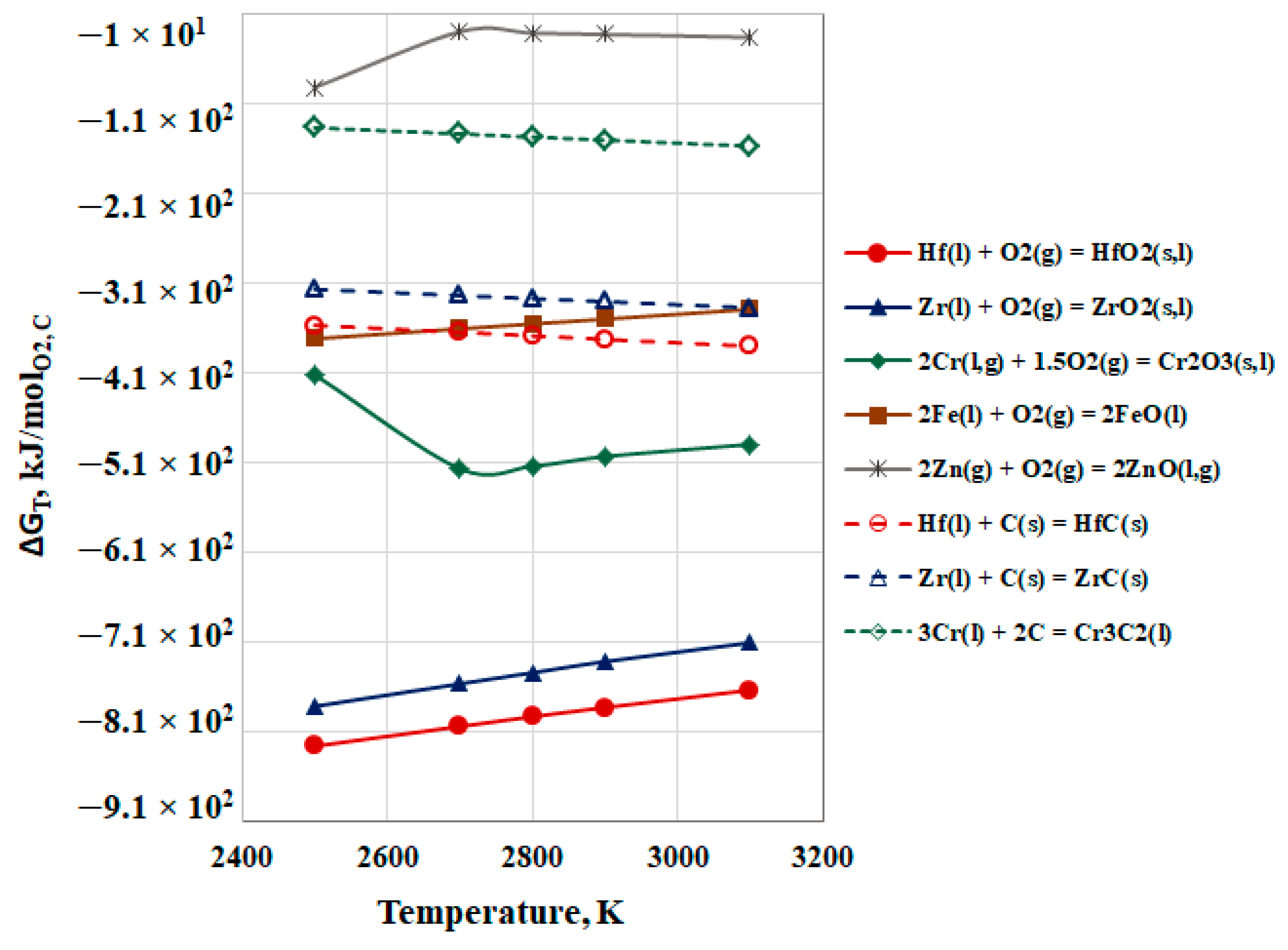




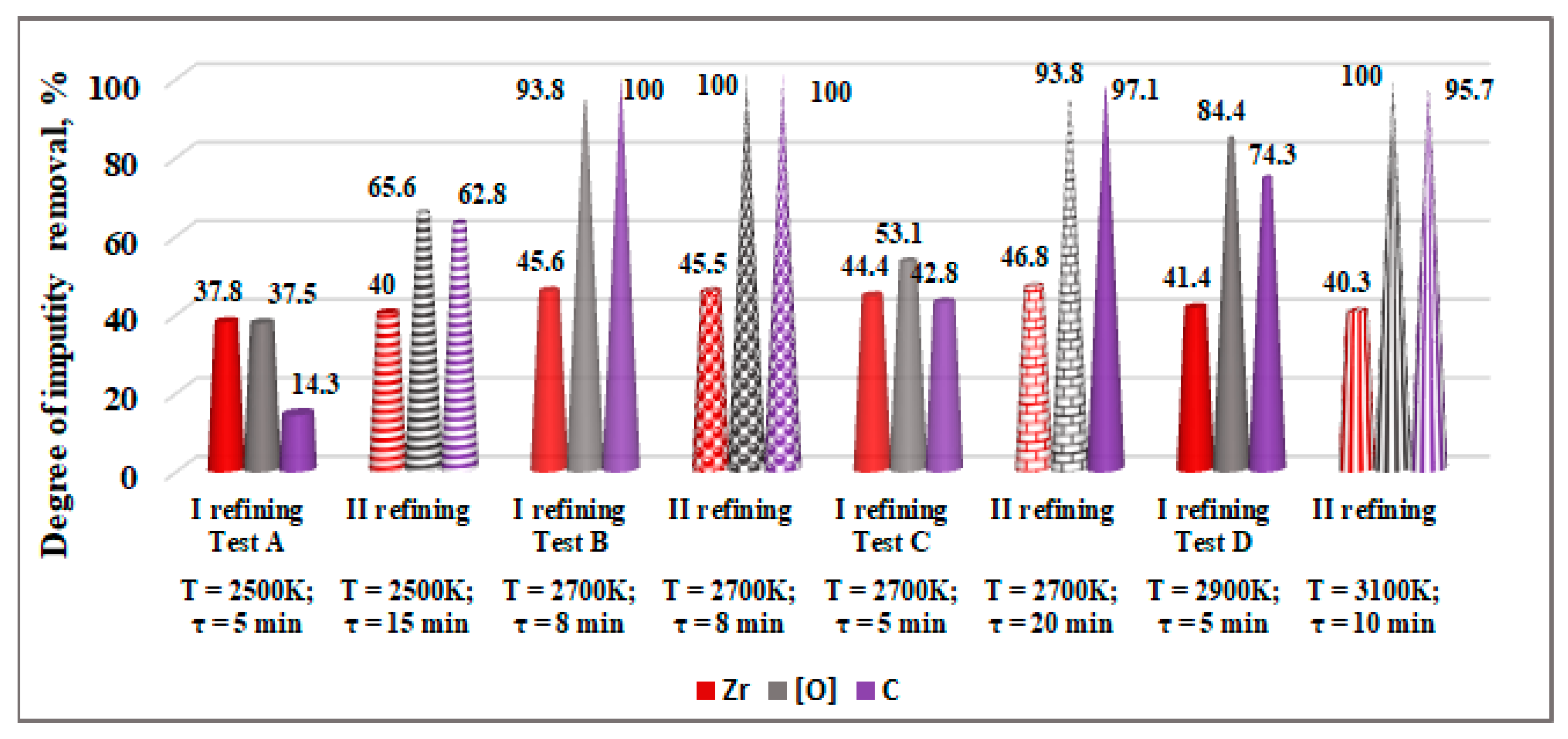
| CHf | CZr | CFe | CCr | CZn | C[O] | CC |
|---|---|---|---|---|---|---|
| 97.870 | 1.868 | 0.147 | 0.042 | 0.006 | 0.032 | 0.035 |
| Probe | T, K | Time min | Concentration of Elements in Mass. % | Σimp, % | ||||||
|---|---|---|---|---|---|---|---|---|---|---|
| Hf | Zr | Fe | Cr | Zn | [O] | C | ||||
| Hf-00 | Initial probe | 97.87 | 1.868 | 0.147 | 0.042 | 0.006 | 0.032 | 0.035 | 2.13 | |
| Hf-03 | 2500 | 5 | 98.78 | 1.162 | 0.006 | 0.002 | <0.001 | 0.02 | 0.03 | 1.220 |
| Hf-01 | 2700 | 5 | 98.925 | 1.039 | 0.001 | <0.001 | <0.001 | 0.015 | 0.02 | 1.075 |
| Hf-08 | 8 | 98.982 | 1.016 | <0.001 | <0.001 | <0.001 | 0.002 | <0.001 | 1.018 | |
| Hf-10 | 2800 | 5 | 98.889 | 1.083 | <0.001 | <0.001 | <0.001 | 0.01 | 0.018 | 1.111 |
| Hf-09 | 8 | 98.925 | 1.073 | <0.001 | <0.001 | <0.001 | 0.002 | <0.001 | 1.075 | |
| Hf-05 | 2900 | 5 | 98.891 | 1.095 | <0.001 | <0.001 | <0.001 | 0.005 | 0.009 | 1.109 |
| Hf-04 | 8 | 98.892 | 1.105 | <0.001 | <0.001 | <0.001 | 0.003 | <0.001 | 1.108 | |
| Test | Refining | T | τ | Concentration of Elements in Mass. % | Σimp,% | ||||||
|---|---|---|---|---|---|---|---|---|---|---|---|
| K | Min | Hf | Zr | Fe | Cr | Zn | [O] | C | |||
| Initial probe | 97.87 | 1.868 | 0.147 | 0.042 | 0.006 | 0.032 | 0.035 | 2.13 | |||
| A | A-I | 2500 | 5 | 98.78 | 1.162 | 0.006 | 0.002 | <0.001 | 0.02 | 0.03 | 1.220 |
| A-II | 2500 | 15 | 98.827 | 1.120 | <0.001 | <0.001 | <0.001 | 0.011 | 0.013 | 1.173 | |
| B | B-I | 2700 | 8 | 98.982 | 1.016 | <0.001 | <0.001 | <0.001 | 0.002 | <0.001 | 1.018 |
| B-II | 2700 | 8 | 98.982 | 1.018 | <0.001 | <0.001 | <0.001 | <0.001 | <0.001 | 1.018 | |
| C | C-I | 2700 | 5 | 98.925 | 1.039 | 0.001 | <0.001 | <0.001 | 0.015 | 0.02 | 1.075 |
| C-II | 2700 | 20 | 99.004 | 0.994 | <0.001 | <0.001 | <0.001 | 0.002 | 0.001 | 0.996 | |
| D | D-I | 2900 | 5 | 98.891 | 1.095 | <0.001 | <0.001 | <0.001 | 0.005 | 0.009 | 1.109 |
| D-II | 3100 | 10 | 98.88 | 1.115 | <0.001 | <0.001 | <0.001 | <0.001 | 0.005 | 1.120 | |
| Probe | Process Parameters | Hardness μHV | Standard Deviation | ||
|---|---|---|---|---|---|
| T, K | τ, Min | MPa | |||
| Hf-00 | Initial probe | 3166 | +/−169 | ||
| Hf-03 | 2500 | 5 | 2802 | +/−149 | |
| Hf-01 | 2700 | 5 | 2620 | +/−54 | |
| Hf-08 | 8 | 2378 | +/−93 | ||
| Hf-10 | 2800 | 5 | 2624 | +/−94 | |
| Hf-09 | 8 | 2568 | +/−50 | ||
| Hf-05 | 2900 | 5 | 2612 | +/−57 | |
| Hf-04 | 8 | 2593 | +/−76 | ||
| Test | Refining (Probe No) | Process Parameters | Hardness μHV | Standard Deviation | |
|---|---|---|---|---|---|
| T, K | τ, Min | MPa | |||
| A | I (Hf-03) | 2500 | 5 | 2802 | +/−149 |
| II (Hf-06-04-3) | 2500 | 15 | 2742 | +/−94 | |
| B | I (Hf-08) | 2700 | 8 | 2378 | +/−93 |
| II (Hf-073) | 2700 | 8 | 2357 | +/−65 | |
| C | I (Hf-01) | 2700 | 5 | 2620 | +/−54 |
| II (Hf-01-10-3) | 2700 | 20 | 2321 | +/−52 | |
| D | I (Hf-05) | 2900 | 5 | 2612 | +/−57 |
| II (Hf-05-02-3) | 3100 | 10 | 2697 | +/−88 | |
Publisher’s Note: MDPI stays neutral with regard to jurisdictional claims in published maps and institutional affiliations. |
© 2022 by the authors. Licensee MDPI, Basel, Switzerland. This article is an open access article distributed under the terms and conditions of the Creative Commons Attribution (CC BY) license (https://creativecommons.org/licenses/by/4.0/).
Share and Cite
Vutova, K.; Stefanova, V.; Markov, M.; Vassileva, V. Study of the Possibility of Recycling of Technogenic Hafnium during Electron Beam Refining. Materials 2022, 15, 8518. https://doi.org/10.3390/ma15238518
Vutova K, Stefanova V, Markov M, Vassileva V. Study of the Possibility of Recycling of Technogenic Hafnium during Electron Beam Refining. Materials. 2022; 15(23):8518. https://doi.org/10.3390/ma15238518
Chicago/Turabian StyleVutova, Katia, Vladislava Stefanova, Martin Markov, and Vania Vassileva. 2022. "Study of the Possibility of Recycling of Technogenic Hafnium during Electron Beam Refining" Materials 15, no. 23: 8518. https://doi.org/10.3390/ma15238518
APA StyleVutova, K., Stefanova, V., Markov, M., & Vassileva, V. (2022). Study of the Possibility of Recycling of Technogenic Hafnium during Electron Beam Refining. Materials, 15(23), 8518. https://doi.org/10.3390/ma15238518







